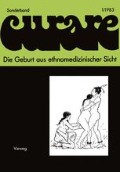Zusammenfassung
Im Rahmen des interdisziplinären Schwerpunktprogramms “Mensch, Kultur und Umwelt im zentralen Hochland von West-Irian” der Deutschen Forschungsgemeinschaft, das von G. KOCH und K. HELFRICH vom Museum für Völkerkunde in Berlin* initiiert worden war, führte ich zwischen Juli 1974 und Juni 1976 21 Monate lang Feldarbeit bei den Eipo durch, einer ethnischen Gruppe, die zur Familie der Mek Sprachen gehört (SCHIEFENHÖVEL 1976, HEESCHEN 1979). Ich konnte die Eipo 1978 erneut kurz besuchen und im April und Mai 1980 eine 5-wöchige Wiederholungsuntersuchung vornehmen. Die Eipo, nach physisch-anthropologischer Definition Pygmäen, sind sehr klein, die männliche Durchschnittskörperlänge beträgt 146–147 cm (Bt)CHI 1981, JÜPTNER 1978). Sie bewohnen das sehr unzugängliche Berggebiet nördlich der zentralen Gebirgskette um den 140. Längengrad und etwa 4° 16’ südlicher Breite.
Access this chapter
Tax calculation will be finalised at checkout
Purchases are for personal use only
Preview
Unable to display preview. Download preview PDF.
Literatur
BÜCHI E. (1978): Physische Anthropologie der Eipo im zentralen Bergland von Irian Jaya (West-Neuguinea), Indonesien. Berlin: D. Reimer.
DUNN P. (1976): Obstetric Delivery Today - For Better or for Worse? Lancet 10: 790.
DUNN P. (1981): Birth from the Pediatrician Point of View Proceedings of the 7th European Congress of Perinatal Medicine, Barcelona 1980.
FRÖSNER G., JÜPTNER H. u. SCHIEFENHÖVEL W. (im Druck): Seroepidemiologische Untersuchungen bei den Eipo im zentralen Hochland von Irian Jaya.
HEESCHEN V. (1979): The Mek Languages of Irian Jaya with Special Reference to the Eipo Language. Irian VII, 2: 3–46.
HEESCHEN V. u. SCHIEFENHÖVEL W. (im Druck): Wörterbuch Eipo-Deutsch-English.
JORDAN B. (1978): Birth in Four Cultures. Montreal & St. Albans: Eden Press.
JÜPTNER H. (1978): Tropenmedizinische Untersuchungen eines Isolats im zentralen Hochland von Irian Jaya (Indonesisch Neuguinea). Acta tropica 35: 83–98.
KIRCHHOFF H. (1977): The Woman’s Posture during Birth–from Prehistoric Times to the Present. Organorama 14: 11–19.
KLAUS H.M.u. KENNELL J.H. (1970): Human Maternal Behaviour at First Contact with her Young. Pediatrics 46, 2: 187–192.
KOCH G. (1977): Die Eipo–Anatomie einer Steinzeitkultur. Bild der Wissenschaft 9: 44–59.
LEBOYER F. (1974): Der sanfte Weg tin’s Leben. München: Desch.
McFARLANE A. (1977): The Psychology of Childbirth. London: Fontana.
MENDEZ-BAUER C. et al. (1975): Effects of Standing Position on Spontaneous Uterine Contractility and Other Aspects of Labour. J. of Perinatal Medicine 3: 85–100.
MENDEZ-BAUER C. et al. (1981): The Dynamics of Labour in Different Positions Proceedings of the 7th European Congress of Perinatal Medicine, Barcelona, Sept. 2nd-5th, 1980.
NAAKTGEBOREN C. (1972): Human delivery in the light of biological views of parturition. In: MORRIS, N. (ed.): Proceedings of the 3rd Congress for Psychosomatic Medicine in Obstetrics and Gynecology. Basel: Karger.
NAAKTGEBOREN C. (1979): Die Geburt bleibt immer ein Wunder. Bild der Wissenschaft Heft 10: 98–112.
NAAKTGEBOREN C. u. SLIJPER E.J. (1970): Die Biologie der Geburt. Hamburg: Parey.
ODENT M. (1976): Bien naitre. Le Seuil.
ODENT M. (1979): Genese de l’Homme écologique. Epi.
SCHIEFENHÖVEL W. (1976): Die Eipo-Leute des Berglands von Indonesisch-Neuguinea. Homo 24, 4: 263–275.
SCHIEFENHÖVEL W. (1980): Verarbeitung von Schmerz und Krankheit bei den Eipo, Hochland von West-Neuguinea. Medizinische Psychologie 6: 219–234.
SCHIEFENHÖVEL W. (1980): “Primitive”’ Childbirth - Anachronism or challenge to “modern” obstetrics? In: BALLABRIGA A. & GALLART A. (ads.): Proceedings of the 7th European congress of Perinatal Medicine, Barcelona.
SCHIEFENHÖVEL G. u. W. (1978): Vorgänge bei der Geburt eines Mädchens und Änderung der Infantizidabsicht. Homo 29, 2: 121–138.
Editor information
Rights and permissions
Copyright information
© 1983 Friedr. Vieweg & Sohn Verlagsgesellschaft mbH, Braunschweig
About this chapter
Cite this chapter
Schiefenhövel, W. (1983). Geburten bei den Eipo. In: Schiefenhövel, W., Sich, D. (eds) Die Geburt aus ethnomedizinischer Sicht. Vieweg+Teubner Verlag. https://doi.org/10.1007/978-3-322-88779-5_4
Download citation
DOI: https://doi.org/10.1007/978-3-322-88779-5_4
Publisher Name: Vieweg+Teubner Verlag
Print ISBN: 978-3-528-07916-1
Online ISBN: 978-3-322-88779-5
eBook Packages: Springer Book Archive

